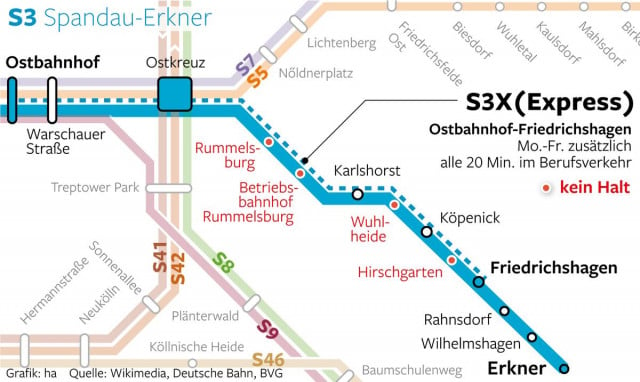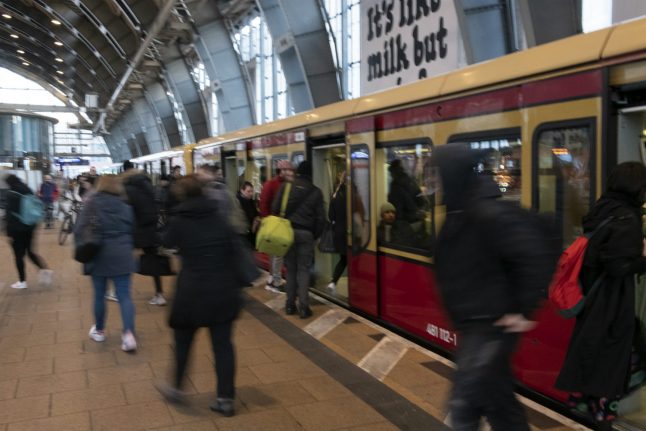The S3 line, which travels from Erkner in Brandenburg to the northwestern suburb of Spandau, is slated to arrive at the destination station four minutes faster than regular trains, reported the Berliner Morgenpost.
However, the amount of time saved could increase to 10 minutes, as passengers at Berlin’s Ostkreuz station can switch – and consequently catch – other trains earlier than before, according to S-Bahn boss Peter Buchner, who presented the new plans Monday on “S-Bahn Passenger Day” in Berlin.
While the regular trains stop eight times between Friedrichshagen and Ostkreuz, the express trains will avoid the stops Hirschgarten, Wuhlheide, 'Betriebsbahnhof (Depot) Rummelsburg' and Rummelsburg.
Still, the waiting time for express trains, as with regular S-Bahn trains, will remain 10 minutes as before, and the trains will only run in the mornings and afternoon.

The following map shows where the new express trains will avoid stopping in order to save time. Photo: Wikimedia Commons
The S-Bahn will be seeing other changes with the new schedule: the S75 will be able to accommodate more passengers as new trains will be equipped with six instead of four wagons.
Starting in 2021, 10 new express S-Bahn trains will be coming to the S-Bahn network, with the additional routes not yet announced.
READ ALSO: 'Install AC and reduce ticket costs': How Berlin should improve its public transport
The S-Bahn has seen a spike in passengers in recent years. In 2018, there were 471.8 million passengers, up 21 percent from 2012.
The S-Bahn currently runs special trains between Berlin’s Olympic Stadium and Charlottenburg, skipping the Heerstraße station, when there are special events.
Years in the making
A plan for having trains pass through individual stations was already drafted by the S-Bahn, which is run by Deutsche Bahn, two years ago.
At the time, transportation experts were working on a programme to improve punctuality.
READ ALSO: People think life in Berlin ends outside of the Ringbahn. They're wrong.
The transport experts reasoned that, if trains skip individual stations, they could quickly make up for their delays, which the crowded 'Ringbahn' trains are particularly susceptible to due to the high number of boarding and exiting passengers.
They proposed that express trains pass through less-frequented Ringbahn stations such as Halensee, Hohenzollerndamm and Heidelberger Platz. Yet after a storm of indignation, the S-Bahn quickly dropped this plan.
Yet, in the current plan, the express trains are an addition to the existing service, meaning that regular trains will still be stopping every 10 minutes at Hirschgarten and Rummelsburg as usual.
'Ghost stations'
The idea for a rapid transportation system stretches back to the 1930s, when so-called “banker trains” with a speed of 120 km/h ran from Zehlendorf in west Berlin to the former Potsdam station in the city centre without stopping.
The “banker trains”, named for the group of commuting professionals most likely to take them, ran every 20 minutes in the morning and hourly during the day.
Starting in the 1950s, special “Durchläufer” (Running through) trains were politically motivated, and simply excluded stops on West Berlin territory during journeys from the surrounding countryside to the eastern part of the city.
Several of these, such as Berlin’s Nordbahnhof, now host photo exhibitions inside documenting the time when they were “ghost stations”.
READ ALSO: 'They were so rude': Berlin newcomer shares S-Bahn horror story



 Please whitelist us to continue reading.
Please whitelist us to continue reading.
Member comments